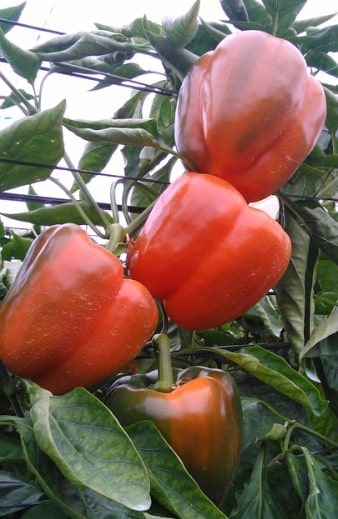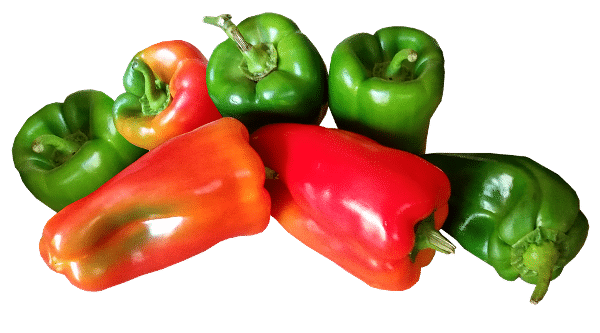How To Grow Bell Peppers (Capsicum) In Backyard
Today, we talk about how to grow bell peppers in your home backyard. Bell pepper which is also called as sweet pepper or capsicum belongs to the family of Capsicum annuum. Bell peppers can be raised in different colors like red, orange, yellow, green and even chocolate brown. Fresh peppers are raw and these will be used in most of the recipes too. The shape of the peppers is round and hollow which will make them the best fit for stuffing once the core of the seed is removed.
Bell peppers are a perennial crop when coming to tropical areas. But in the areas where the climate is cold, bell peppers are grown as annual crops and they do not have much tolerance to cold temperatures.
Growing bell peppers in the backyard are very easy, but they are fussy about the requirements regarding the temperature. If the climate is irregular as if there is no sufficient warmth, your harvest of bell pepper might not reach your expectation.
Sweet bell peppers are the ones which are popular for their rich content of vitamin C and they also have sufficient amounts of vitamin A and B6.
Climate, water and soil requirement for the growth of bell peppers in the backyard:
Bell peppers will need full sun for optimum growth and the soil which is being used for the growth of bell peppers should be very rich in the content of calcium. Watering should be done on a frequent basis. Germination of seeds will take almost two weeks and the harvest will occur after 2 to 3 months of the plantation.
Seeding:
- Bell peppers will need a growing season which is long i.e., up to 2 to 3 months. So, the shorter the summer, sooner you will require to start seeds in the indoor locations.
- Storage of seeds is always possible from the bell peppers which are bought from an organic store. You will need to collect the seeds from red peppers as they will be more mature than the bell peppers which are green. These seeds should be set out dry for some days.
- After that, you can sow them or you can even store them by using a paper envelope and keep them in a location which is dry and is also safe for keeping.
- Make sure that you are not putting your bell pepper plant in the outdoor garden till the climate and soil are warm. Start seeding in the indoor environment in order to get your harvest prior to winter.
- Get to know your last frost date which is expected and start the plantation of your pepper seeds before eight weeks of your expected frost date.
- Always be ready to pamper your pepper seedlings as they like to be warmth. Pepper seeds should reach half inch depth into the soil and the seed pots should be kept at a temperature of 26°C for the germination to take place in a perfect way.
- Once you see sprouts, you can decrease the temperature of 21°C but make sure that it is not less than 16°C at night time.
- If the seedlings are placed in trays, you need to move them into the pots which are of three inches after few weeks so that the roots will get enough time for their growth.
Read: Advantages of Terrace Gardening.
Varieties of bell peppers:
Yellow Canary bell:
These type of bell peppers will take almost three months to reach the stage of maturity. But this would be worth the wait as you will get a chance to enjoy these 4-inch yellow fruits.
Big red:
This will take almost two and a half months to harvest. This will turn from green color to red color as it ripens. This sweet pepper will have flesh which is thick and is a mixture of 3 to 4 lobby blocky fruits.

Coral bell:
Coral bell has a vibrant orange color and these will add additional beauty to the backyard. These will grow vigorously and produce four-lobed fruit which will reach about the size of 4 inches at the stage of maturity.
California wonder:
This type of bell pepper will be delicious if picked when it is in green color. Else, it can be left on the pepper plant and allow to ripen for a red pepper which is sweeter.
This is a four-lobed fruit which is pepper which is deliciously stuffed. It will have a size of 4 inches. These are the fruits which are resistant to the Tobacco Mosaic Virus and these will reach the stage of maturity in 75 days.
Purple beauty:
This is an heirloom pepper which will look striking with a deep purple color. The flesh of this fruit will be thick and the size of the fruit will be 4 inches maximum. These will take approximately 70 days to reach the maturity stage.
Chocolate beauty:
This bell pepper will have a deep brown color whose flesh is also super sweet. The growth of this plant will be too quick and this will reach the maturity stage within 65 days. This bell pepper is also resistant to Mosaic tobacco virus.
Transplantation:
- You will keep your pepper plants outdoor after about 21 days after the last frost date.
- The soil must be dug thoroughly and make sure that you are adding extra compost so that it acts as a feed for your peppers. Lime will add more amount of calcium to your pepper plants and will also help in the prevention of blossom rot.
- The holes should be of sufficient depth for the accommodation of the roots of seedlings, but make sure that you are not planting it deeper. The stem of the plant should not be covered. You will be required to have about 10 inches of space between the pepper plants as they will not grow larger than that.
- When you choose a site for your pepper plants, they will require full sun and they should also be protected from winds. Placing the pepper plants near a wall will be a good idea as long as it does not shade the plants.
Read: Homemade Hydroponic Nutrient Solution.
Care and Maintenance:

- If you allow your pepper plants to over dry too often, the peppers will have a bitter taste. Ensure that you are watering the plants on a regular basis so that there would be the right development of fruit.
- The fertilization can be done all around the growing season, but make sure that you are not using the formulas which have high levels of nitrogen. High amounts of nitrogen will give rise to very leafy plants with tiny fruit or sometimes there would not be any fruit. Fish emulsion will increase the levels of phosphorus too.
- Once the peppers start growing on your plants, you will want to stake them. Peppers which are large will be slightly heavy for the small plants making them bend.
- The cages which are used for growing tomatoes will be of huge help in this case but you will need to keep the cages in place when the pepper plants are still small. Do not try caging a pepper plant which is fully grown. If you do so, you will cause damage not only to the roots of the pepper plant but also to its branches.
- As peppers love to be in warmth, most of the gardeners will use a plastic cover which is black in color on the soil rather than a normal mulch. It will help to maintain heat and moisture in the soil. This will also help in eradicating the weeds.
- Though heat is loved by the peppers, the blossoms will be dropped without any sort of development in fruit if the temperature rises above 32°C during day times. It will not cause any permanent damage to the pepper plant and the fruit setting initiates once the climate goes back to the temperature ranges which are preferred for their growth.
Containers:
The production of peppers will have small plants and they work very fine when placed in containers. A pot which is of 12 inches will be able to handle pepper plants. The potting soil should be mixed with some amount of compost for the sake of nutrients and the watering should be done on a regular basis. The containers should be placed along a sunny wall so that the wall will be able to reflect the heat onto the plants which will give additional warmth to the pepper plants.
Few varieties like blushing beauty will look small for containers but actually, any type of bell pepper can be raised in a pot.
Pests and diseases:
- The pepper plants will be usually affected by tobacco mosaic virus. So make sure that you are never touching your pepper plants after handling any sort of tobacco. Tobacco also means cigarettes. The symptoms that the pepper plant is affected by this type of virus is that the leaves become yellow and mottled and the growth of the plant gets stunted.
- Mosaic can also be spread by aphids. So take proper care to control any sort of infestations of aphid by using the sprays of insecticides. Aphids will be eaten by ladybugs and they will be of great help in eradicating the pests from your pepper plants. You can also buy varieties of pepper which are resistant to mosaic virus.
- Once the fruits start growing, you will see that the end where the blossom starts will turn into black color and soon rots.
- It is actually called blossom end rot and this occurs when there is no sufficient amount of calcium in the soil. You will not be able to save the fruit which is rotting, but when you add lime to the soil, it may help in the prevention of problem with other peppers present in the plant.
- Do not allow the accumulation of water and leaf debris under the plants and treat them with a fungicide if you come to see such kind of development. As soon as the lesions grow around the stem of the pepper plant, it will mostly die.
Harvesting and storage:

- From a bell pepper plant which is healthy, you can mostly harvest 6 to 10 number of peppers which are of good size. The fruits will be firm and they will be of any color they are supposed to be like yellow, red or green. You can start picking them when they are small as long as they are firm so that they can be used. But, in this case, the content of vitamin gets reduced.
- Be very careful while picking the bell peppers so that you will not cause any harm to the rest of the bush. You can either snip them by making use of garden clippers or you can even twist them by holding the pepper plant with your other hand.
- When you have large peppers and their color has been finalized, make sure that you are not leaving them on the plant for much time. This will trigger the pepper plant which will make the plant stop flowering and will cut short your period of harvest.
- Peppers which are fresh can be stored in the refrigerator for about seven days. Bell peppers which are raw can be made to freeze once they are cored.
Read: Types of seed sowing.